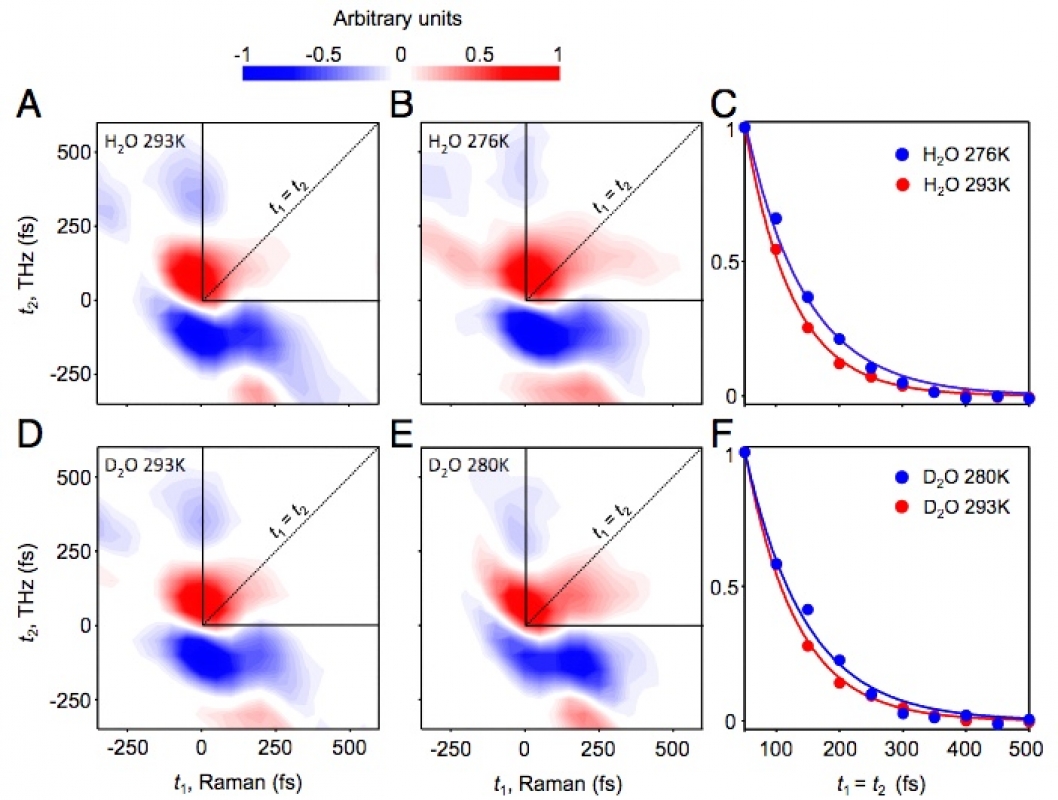Impact of nuclear quantum effects on the structural inhomogeneity of liquid water
January 28, 2019The degree to which water is structured is an extremely intriguing problem and a matter of ongoing debate.
The 2D Raman–terahertz (THz) response of liquid water is studied in dependence of temperature and isotope substitution (H2O, D2O, and H182O). In either case, a very short-lived (i.e., between 75 and 95 fs) echo is observed that reports on the inhomogeneity of the low-frequency intermolecular modes and hence, on the heterogeneity of the hydrogen bond networks of water. The echo lifetime slows down by about 20% when cooling the liquid from room temperature to the freezing point. Furthermore, the echo lifetime of D2O is 6.5±1% slower than that of H2O, and both can be mapped on each other by introducing an effective temperature shift of ∆T=4.5±1 K. In contrast, the temperature-dependent echo lifetimes of H182O and H2O are the same within error. D2O and H182O have identical masses, yet H182O is much closer to H2O in terms of nuclear quantum effects. It is, therefore, concluded that the echo is a measure of the structural inhomogeneity of liquid water induced by nuclear quantum effects.

Figure: 2D Raman–THz–THz responses of neat H2O and D2O at different temperatures. Full 2D signals for H2O at (A) 293 K and (B) 276 K as well as for D2O at (D) 293 K and (E) 280 K. The upper right quadrants, which correspond to the Raman–THz–THz pulse sequence, and the main diagonals t1=t2 (dotted lines) are indicated. C compares 1D cuts along the t1=t2 diagonal for H2O at 293 K (red line) and 276 K (blue line), and F compares those for D2O at 293 K (red line) and 280 K (blue line), in either case together with single exponential fits (solid lines). The 1D and 2D data are normalized to the maximum signal, and the 1D cuts start at 50 fs, after which time the effects of the pump-probe pulse overlap can be neglected.
See also:
Reference: Berger, A., G. Ciardi, D. Sidler, P. Hamm and A. Shalit (2019). Impact of nuclear quantum effects on the structural inhomogeneity of liquid water. Proc. Natl. Acad. Sci. U.S.A.: 201818182 (10.1073/pnas.1818182116)  Berger-20191
Berger-20191
<<

 Ursula Keller wins “Swiss Nobel” Marcel Benoist Prize
Ursula Keller wins “Swiss Nobel” Marcel Benoist Prize Farewell: the NCCR MUST ended
Farewell: the NCCR MUST ended  MUST2022 Conference
MUST2022 Conference New scientific highlights
New scientific highlights FELs of Europe prize for Jeremy Rouxel
FELs of Europe prize for Jeremy Rouxel Ruth Signorell wins Doron prize
Ruth Signorell wins Doron prize New FAST-Fellow Uwe Thumm at ETH
New FAST-Fellow Uwe Thumm at ETH International Day of Women and Girls in Science
International Day of Women and Girls in Science New scientific highlight
New scientific highlight EU XFEL Young Scientist Award for Camila Bacellar,
EU XFEL Young Scientist Award for Camila Bacellar, Prizes for Giulia Mancini and Rebeca Gomez Castillo
Prizes for Giulia Mancini and Rebeca Gomez Castillo Nobel Prize in Chemistry awarded to RESOLV Member Benjamin List
Nobel Prize in Chemistry awarded to RESOLV Member Benjamin List Hans Jakob Wörner invited to give the „New Horizons Solvay Lectures”
Hans Jakob Wörner invited to give the „New Horizons Solvay Lectures”  Unusual keynote talk at an international scientific conference
Unusual keynote talk at an international scientific conference NCCR MUST at Scientifica 2021
NCCR MUST at Scientifica 2021